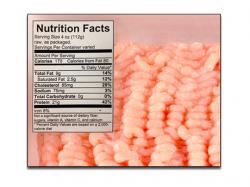Key Nutrition Information For Most Popular Meat & Poultry Products Coming To A Store Near You
March 2, 2012 | 3 min to read

WASHINGTON – Beginning March 1, consumers will have convenient access to important nutritional information about the raw meat and poultry products they most frequently purchase, the U.S. Department of Agriculture's Food Safety and Inspection Service (FSIS) announced. Under a new FSIS rule, packages of ground or chopped meat and poultry, such as hamburger or ground turkey, will now feature nutrition facts panels on their labels. Additionally, 40 of the most popular whole, raw cuts of meat and poultry, such as chicken breast or steak, will also have nutritional information either on the package labels or on display to consumers at the store.
"Providing nutrition information on meat and poultry products in the store gives shoppers a clearer sense of the options available, allowing them to purchase items that are most appropriate for their families' needs," said Under Secretary for Food Safety Dr. Elisabeth Hagen. "These new labels mark a significant step in the agency's efforts to help consumers make more informed food purchase decisions."
The new nutrition facts panels will list the number of calories and the grams of total fat and saturated fat that a product contains. For example, consumers will be able to compare the calories and fat content for ground turkey versus ground beef, or for pork chops versus chicken breasts, right in the store. Additionally, a ground or chopped product that includes on its label a lean percentage statement, such as "85% lean," and is not considered "low in fat" also will list its fat percentage, making it easier for consumers to understand the amounts of lean and fat content in a particular product. Consumers will no longer have to guess which products fit their diets.
The Federal Register notice announcing this rule was published on Dec. 29, 2010 and can be found at federalregister.gov/a/2010-32485. To see examples of the types of labels consumers will now see, click here.
Since 1993, FSIS has required nutrition labeling for products that are not raw or that contain multiple ingredients. FSIS is tasked with ensuring that its regulated products are labeled in a way that is truthful and not misleading.
Consumers with questions about the new labels or other food safety issues can "Ask Karen," the FSIS virtual representative available 24 hours a day at www.AskKaren.gov or via smartphone at m.askkaren.gov. "Ask Karen" live chat services are available Monday through Friday from 10 a.m. to 4 p.m. ET. The toll-free USDA Meat and Poultry Hotline 1-888-MPHotline (1-888-674-6854) is available in English and Spanish and can be reached from 10 a.m. to 4 p.m. ET Monday through Friday. Recorded food safety messages are available 24 hours a day.
Over the past two years, FSIS has announced several new measures to safeguard the food supply, prevent foodborne illness, and improve consumers' knowledge about the food they eat. These initiatives support the three core principles developed by the President's Food Safety Working Group: prioritizing prevention; strengthening surveillance and enforcement; and improving response and recovery. Some of these actions include:
-
Performance standards for poultry establishments for continued reductions in the occurrence of pathogens. After two years of enforcing the new standards, FSIS estimates that approximately 5,000 illnesses will be prevented each year under the new Campylobacter standards, and approximately 20,000 illnesses will be prevented under the revised Salmonella standards each year.
-
Zero tolerance policy for six Shiga toxin-producing E. coli (STEC) serogroups. Raw ground beef, its components, and tenderized steaks found to contain E. coli O26, O103, O45, O111, O121 or O145 will be prohibited from sale to consumers. USDA will launch a testing program to detect these dangerous pathogens and prevent them from reaching consumers.
-
Test and hold policy that will significantly reduce consumer exposure to unsafe meat products, should the policy become final, because products cannot be released into commerce until Agency test results for dangerous contaminants are known.
-
Labeling requirements that provide better information to consumers about their food by requiring nutrition information for single-ingredient raw meat and poultry products and ground or chopped products.
- Public Health Information System, a modernized, comprehensive database about public health trends and food safety violations at the nearly 6,100 plants FSIS regulates.
Source: USDA FSIS
